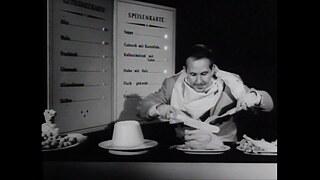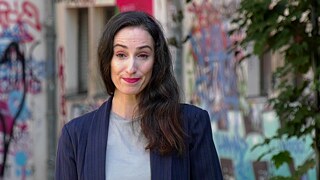The Goethe-Institut
At home and abroad
Migration, climate change, globalisation and, most recently, the pandemic have changed the Goethe-Institut’s work in Germany. From the “Mein Weg nach Deutschland” (My Path to Germany) web portal to international exchange on visions for the future: How the Institut’s work resonates at home.
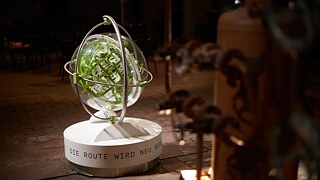
How the Goethe-Institut’s work resonates at home
The teacher sits in front of the camera, somewhat stiffly, and ties a large serviette around his neck. He begins the educational film about customs in German restaurants with the words, “Ich habe Hunger,” (I am hungry). The menu includes goulash, veal escalope and steamed fish. Eating habits in Germany have changed since the 1960s when the Goethe-Institut began using films to teach the first guest workers language skills for life in Germany. This is in part thanks to those self-same immigrants who brought a new diversity of foods with them: Pizza, spaghetti and kebabs have long since conquered the dining tables of Germany.Today, the Goethe-Institut’s commitment extends far beyond the language courses it offers. The “Mein Weg nach Deutschland” (My Path to Germany) web portal, which was developed back in 2012 and gets around 700,000 hits a year, helps immigrants avoid many pitfalls in their new home country. Available in 30 languages, the portal teaches key life skills for living in Germany, such as how to use various media or how to navigate things like going to the authorities when they first arrive in Germany. Developed in 2016 by the Goethe-Institut in cooperation with the Federal Employment Agency, Bayerischer Rundfunk and the Federal Office for Migration and Refugees, the “Ankommen” (Arrive) app also guides newcomers through the first steps. Food-related topics are still addressed, but instead of the rules of etiquette for eating goulash, current topics include which foods are halal and which contain gelatine from pigs.
Better prepared –
more easily integrated
Rising immigration to Germany has expanded the domestic policy dimensions of the Goethe-Institut’s work: After all, the better immigrants are prepared for life in Germany, the easier they will find integration.Germany depends on immigration today and will continue to in future as the large number of babies born in the 1960s gradually retire from the workforce. The resulting shortage of skilled workers is already visible in some professions: According to estimates, up to three million skilled workers will be needed by 2030, which is why a law was passed to allow immigration from third countries outside the EU in 2020.
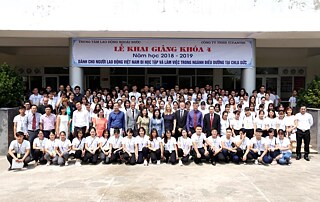
Participants at the language qualification course for nursing professionals at the Goethe-Insitut Vietnam. | Photo: Goethe-Institut Vietnam
There is already a glaring shortage of nursing professionals, for example, with around 30,000 unfilled positions. So the summer of 2021, the Goethe-Institut concluded a cooperation agreement with professional associations in the care sector to jointly provide language and intercultural training for foreign professionals – even before they leave their home countries. Dien Ngoc Nguyen from Vietnam, who works as a carer in Berlin and completed a twelve-month specialised language qualification course for nursing staff at the Goethe-Institut Vietnam, emphasises how important this preparation is: “After four years in Germany, I have valuable advice for Vietnamese course participants,” Dien Ngoc Nguyen says. “Take advantage of all the great opportunities the Vivantes programme in Vietnam offers for improving your German. You won’t have much time for it during training.”
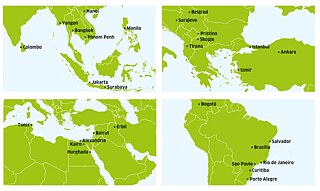
The various Goethe-Institut sites that offer preparatory classes with immigration information and support. | Collage: Goethe-Institut
Every year, the Goethe-Institut provides information and support to 16,000 people worldwide planning to immigrate to Germany for professional or private reasons.
In response to changes in Germany’s immigration policy, the Goethe-Institut is investing more in language instruction abroad. Since 2007, for example, immigrant spouses have had to demonstrate a basic knowledge of German if they want to join their spouses in Germany. This regulation led to a surge in demand for courses, especially at the institutes in South-eastern Europe. In Bosnia and Herzegovina, for example, an average of just eight candidates took the corresponding exam at the institute every year. This jumped to around 800 in 2008.
Exchange is not a one-way street

In other words, immigrants are not the only ones who need to adapt. Germany’s citizens also need to listen to the voices from other countries and cultures and face the world, so to speak. The Goethe-Institut serves as a mediator in this process. Former Chancellor Angela Merkel called the effort to explore Germany’s image at home and abroad an “invaluable service”, making this plea for more unity in response to the “Außensicht” study the Goethe-Institut conducted together with the German Academic Exchange Service (DAAD) and Gesellschaft für Internationale Zusammenarbeit (GIZ) in 2021. The study assessed how Germany was viewed around the world.
The results were mixed: Respondents were very positive about Germany’s economic power, its healthcare system and role in international relations. On the other hand, extremist tendencies, environmental scandals and the lack of digitisation attracted negative attention abroad.
The German attitude toward its own colonial past proved to be another negative perception. This is also a good example of the backlash from international voices to the discourse at home. There is an ongoing debate in Germany about the restitution of colonial cultural assets in museums up and down the country. The “International Inventories Programme” by The Nest (Kenya) and SHIFT (Germany/France) artist collectives raises the question of returning looted art and looks at the positions of both Europeans and the countries concerned. Along with the Goethe-Institut, the National Museum of Kenya, the Rautenstrauch-Joest-Museum in Cologne, the Weltkulturen Museum in Frankfurt am Main and, as exhibition sponsor, the German Federal Cultural Foundation are involved in the project.
As a port city, Hamburg was a centre of German colonialism, and the traces of this period are inscribed in the cityscape. The Goethe-Institut’s International Centre for Cultural Education in Hamburg has set itself the task of rendering this concealed history visible again and thus contributing to the decolonialisation of public spaces with the “ReMapping Memories Lisboa – Hamburg” project.
The online project gathers information on (post-)colonial places of remembrance in Hamburg and Lisbon on a website and serves as a good example of the work carried out by the newly established Goethe-Institut international centres for cultural education in Bonn, Dresden, Mannheim, Schwäbisch Hall and Hamburg. “Through our worldwide Goethe-Institut network, we fully support initiatives and projects that strengthen a plural and diverse society in Germany and add international perspectives,” Schayan Riaz, director of the centre in Hamburg, says of collaboration with partners in Lisbon and Hamburg. “We have plans to use ‘ReMapping’ in other contexts too. We will be taking it into schools and using the project’s content to explore the topic of (post)colonialism.”
Welcoming outside voices in
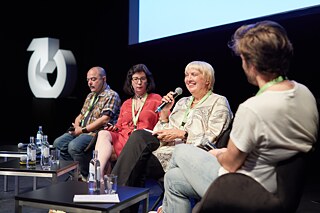
Since 2016, international experts have met at the Kultursymposium Weimar in the Thuringian city every two years to discuss options for finding our way in our increasingly complex world. More than 70 experts from 35 countries attended in 2019, which surprised even moderator Vivian Perkovic.
Translation: Sarah Smithson-Compton
